242. Greater Painted-Snipe Rostratula benghalensis (Goudsnip)
Order: Charadriiformes. Family: Rostratulidae
Description
Size 23-26 cm. A medium-sized, attractive water bird, the Greater Painted-snipe is unusual amongst birds because the female is larger and more brightly coloured than the male.
Female is larger and more striking than male, with a white eye patch, which contrasts the dark red-brown head and chestnut neck. The upperparts are dark bronze-green with fine black barring and the wings are dark grey, white and gold.
The male greater painted-snipe has a conspicuous golden eye patch that sits in stark contrast with the grey-brown head, ash-grey neck, and white streaked throat. The upperparts and wings are gold, brown and black, a golden “V” streaks the male’s back, and the underparts are white.
Both sexes have a conspicuous pale harness extending upwards from the breast and a long, slightly downward-curving bill, which is superbly adapted for probing for prey in water and mud, and have long legs with partially webbed feet, an adaptation for walking in water and on muddy ground.
The juvenile resembles the male.
Similar species: Male distinguished from African Snipe and Great Snipe by its breast pattern, longer legs, and shorter, slightly decurved pale bill. It has a laboured flight action on broad wings.
Distribution
The Greater Painted-snipe occurs from Africa and Madagascar, eastwards to Pakistan, north-eastern China, south-eastern Russia, and south-east Asia. In southern Africa it is rare to locally fairly common in Zimbabwe, northern and eastern Botswana, Namibia (Etosha, Kunene River estuary, Caprivi, central and northern Namibia.) and isolated patches of Mozambique and South Africa.
Habitat
Skulks among reeds in marshes and on the edges of lakes, vleis, dams and seasonally inundated ponds and river flood plains.
Movements and migrations
Little known, although it is generally most abundant in southern Africa in summer, from December-March, while it is most common in the Sahel in the period from July-August. This suggests that it migrates north to avoid the dry season.
Diet
Despite feeding mainly on invertebrates such as insects, snails and earthworms, the greater painted-snipe is omnivorous and will also eat seeds, rice and a variety of grasses. Food is found by probing its long bill into soft mud or by searching underwater, making side to side head movements until it makes contact with, and grasps prey with its sensitive bill. Although primarily crepuscular, the greater painted-snipe occasionally forages at night.
Breeding
Serially polyandrous, as each female mates with 2-4 males per breeding season, although only one male at any one time helps with incubation and the care of the chicks. The nest is a slight depression in vegetation, concealed by overhanging sedges or grasses; it rarely uses a scrape in open mud flats instead. Egg-laying season is from about July-April, peaking from September-March. The female lays 2-5 eggs, which are incubated solely by the male for about 15-19 days, although the female occasionally helps out. The chicks leave the nest about 12 hours after they hatch, sticking close to the male, who provides them with food for at least the first 10 days (at which point they start to forage for themselves). The male may also perform distraction displays if a predator approaches. They fledge at about 30-35 days old, remaining with the male for another 1-2 months.
Status
Scarce resident, with local movements. The Greater Painted-snipe is classified as Least Concern (LC) on the IUCN Red List.
Call
Male utters a trill; female gives a distinctive, soft, disyllabic wuk-oooooo, repeated monotonously, often after dark. Listen to Bird Call.
Africa Wild Bird Book
- nan
- Posts: 26476
- Joined: Thu May 31, 2012 9:41 pm
- Country: Switzerland
- Location: Central Europe
- Contact:
Greater Painted-Snipe Photos
242. Greater Painted-Snipe Rostratula benghalensis
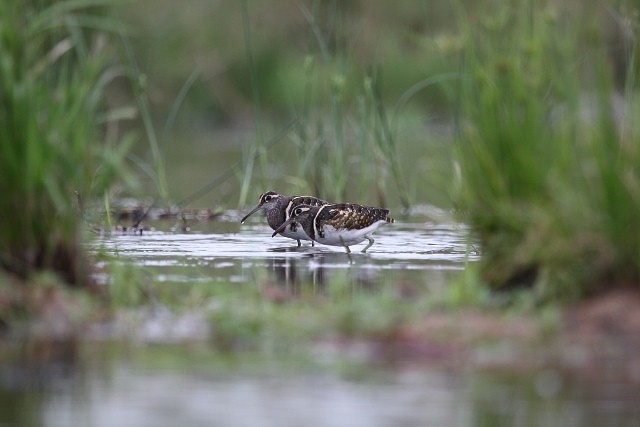 © nan
© nan
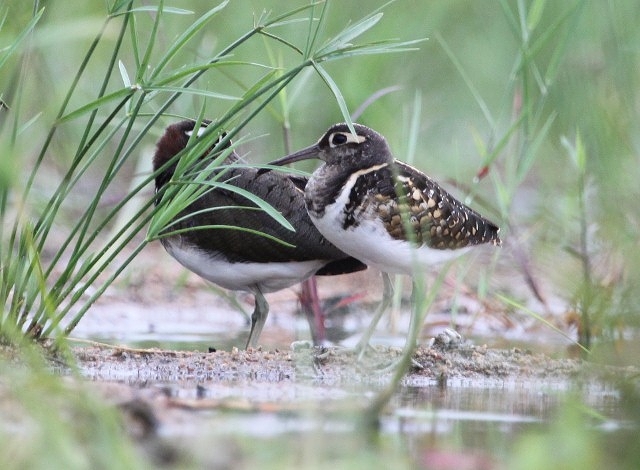 © nan
© nan
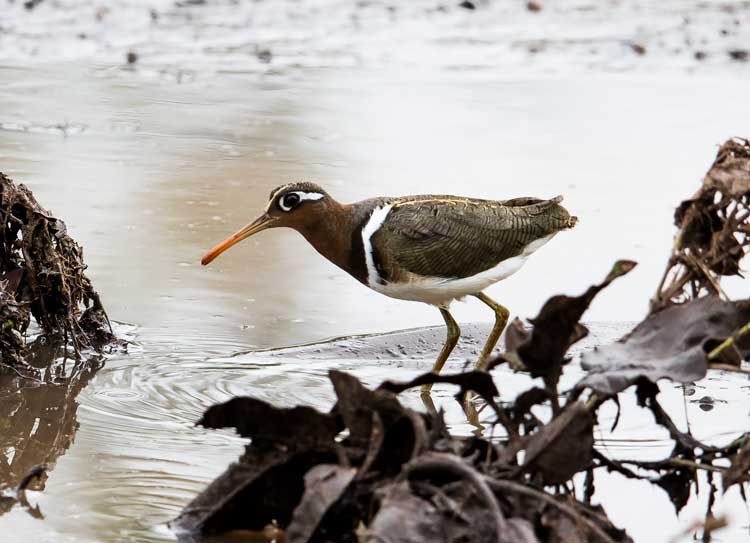 © Pumbaa
© Pumbaa
Kruger National Park, S41
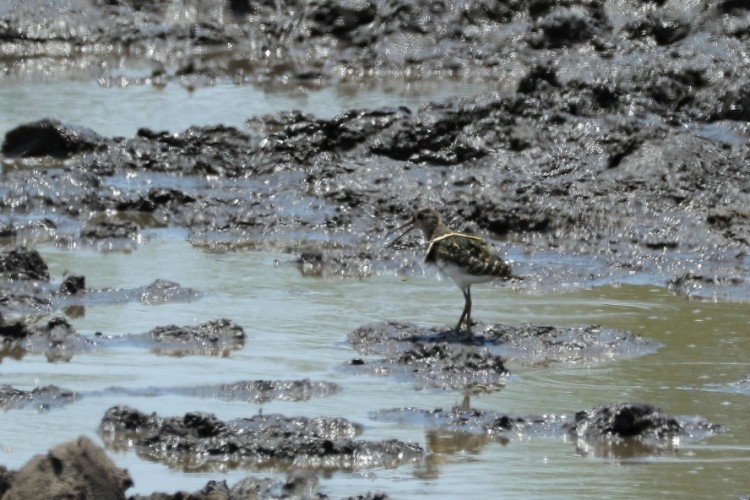 © Dindingwe
© Dindingwe
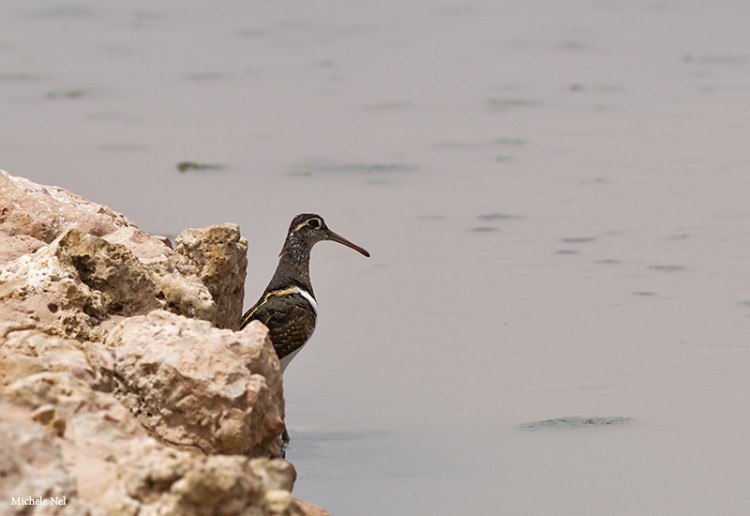
Kgalagadi Transfrontier Park, 13th Borehole - 18/02/2018 © Michele Nel
Links:
http://faansiepeacock.com/wp-content/up ... hapter.pdf
Species text in The Atlas of Southern African Birds
Sabap2
ARKive
Oiseaux net: http://www.oiseaux-birds.com/card-great ... snipe.html
 © nan
© nan © nan
© nan © Pumbaa
© PumbaaKruger National Park, S41
Kgalagadi Transfrontier Park, 13th Borehole - 18/02/2018 © Michele Nel
Links:
http://faansiepeacock.com/wp-content/up ... hapter.pdf
Species text in The Atlas of Southern African Birds
Sabap2
ARKive
Oiseaux net: http://www.oiseaux-birds.com/card-great ... snipe.html
Kgalagadi lover… for ever
https://safrounet.piwigo.com/
https://safrounet.piwigo.com/
Family Jacanidae (Jacanas)
The jaçanas (sometimes referred to as lily trotters) are a group of tropical waders in the family Jacanidae. They are found worldwide within the tropical zone. See Etymology below for pronunciation.
Eight present species of jaçana are known from six genera. They are identifiable by their huge feet and claws which enable them to walk on floating vegetation in the shallow lakes that are their preferred habitat. They have sharp bills and rounded wings, and many species also have wattles on their foreheads.
The females are larger than the males; the latter take responsibility for incubation, and some species are polyandrous. However, adults of both sexes look identical. They construct relatively flimsy nests on floating vegetation, and lay eggs with dark irregular lines on their shells, providing camouflage amongst water weeds. Their diet consists of insects and other invertebrates picked from the floating vegetation or the water’s surface.
Eight present species of jaçana are known from six genera. They are identifiable by their huge feet and claws which enable them to walk on floating vegetation in the shallow lakes that are their preferred habitat. They have sharp bills and rounded wings, and many species also have wattles on their foreheads.
The females are larger than the males; the latter take responsibility for incubation, and some species are polyandrous. However, adults of both sexes look identical. They construct relatively flimsy nests on floating vegetation, and lay eggs with dark irregular lines on their shells, providing camouflage amongst water weeds. Their diet consists of insects and other invertebrates picked from the floating vegetation or the water’s surface.
Family Jacanidae (Jacanas) Index
Species indigenous to southern Africa:
Family Jacanidae (Jacanas)
Microparra capensis Lesser Jacana 241
Actophilornis africanus African Jacana 240
Family Jacanidae (Jacanas)
Microparra capensis Lesser Jacana 241
Actophilornis africanus African Jacana 240
-
Klipspringer
- Global Moderator
- Posts: 5858
- Joined: Sat Sep 14, 2013 12:34 pm
- Country: Germany
- Contact:
Lesser Jacana
241. Lesser Jacana Microparra capensis
Order: Charadriiformes. Family: Jacanidae
Description
Small waterbird with long legs and toes. Adult is half the size of adult African Jacana, but resembles chick of that species. However, adult Lesser Jacana has chestnut crown and eye stripe, and can be distinguished by wing pattern in flight: it has pale upperwing coverts, blackflight feathers with white trailing edges, and anotherwise black underwing.
Distribution
Occurs discontinuously in sub-Saharan Africa, including patches of the area from Senegal to Ethiopia, however it is especially widespread from Uganda, Tanzania, Zambia and Angola to southern Africa. Within southern Africa it is uncommon to locally common in eastern KwaZulu-Natal, small parts of Mozambique and Zimbabwe, while it is most common in northern Botswana and the Caprivi Strip (Namibia). Abundant in the Okavango Delta, which supports globally important numbers of the species and is its southern African stronghold.
Habitat
It generally prefers shallow, freshwater wetlands and backwaters of lakes and dams, especially with emergent grasses (such as Leersia and Hemarthria), sedges (including Rhynchosporia, Eliocharis, Cyperus and Juncus) and water-lilies (mainly Nymphaea and Nymphoides).
Movements and migrations
Highly nomadic, moving in search of fresh ephemeral wetlands.
Diet
It mainly eats insects, doing most of its foraging by walking on floating plants, plucking prey from the vegetation.
Breeding
Monogamous, solitary nester; the male builds several simple display platforms, giving a hooting call in order to attract females.
The nest is built by both sexes, consisting of a tiny floating stack of plant stems, typically placed alongside a grass or sedge tuft. If it is flooded both adults work tirelessly to build a new platform to move the eggs to. Egg-laying season is from February-November, peaking from March-April.
It lays 2-5 eggs, which are incubated by both sexes for approximately 21 days. The chicks remain within two metres of the nest for the first three days of their lives, ranging up to 150 metres away by the time they reach 17 days of age. When threatened they dive underwater, with just the bill tip protruding so that they can breathe. The parents intermittently brood them for the first month or so of their lives by holding them between wing and body. They typically take their first flight at roughly 32 days old and can fly well a week later, becoming fully independent at approximately 63 days old.
Call
Silent, except for an occasional kruk.
Status
Uncommon localised resident.
Order: Charadriiformes. Family: Jacanidae
Description
Small waterbird with long legs and toes. Adult is half the size of adult African Jacana, but resembles chick of that species. However, adult Lesser Jacana has chestnut crown and eye stripe, and can be distinguished by wing pattern in flight: it has pale upperwing coverts, blackflight feathers with white trailing edges, and anotherwise black underwing.
Distribution
Occurs discontinuously in sub-Saharan Africa, including patches of the area from Senegal to Ethiopia, however it is especially widespread from Uganda, Tanzania, Zambia and Angola to southern Africa. Within southern Africa it is uncommon to locally common in eastern KwaZulu-Natal, small parts of Mozambique and Zimbabwe, while it is most common in northern Botswana and the Caprivi Strip (Namibia). Abundant in the Okavango Delta, which supports globally important numbers of the species and is its southern African stronghold.
Habitat
It generally prefers shallow, freshwater wetlands and backwaters of lakes and dams, especially with emergent grasses (such as Leersia and Hemarthria), sedges (including Rhynchosporia, Eliocharis, Cyperus and Juncus) and water-lilies (mainly Nymphaea and Nymphoides).
Movements and migrations
Highly nomadic, moving in search of fresh ephemeral wetlands.
Diet
It mainly eats insects, doing most of its foraging by walking on floating plants, plucking prey from the vegetation.
Breeding
Monogamous, solitary nester; the male builds several simple display platforms, giving a hooting call in order to attract females.
The nest is built by both sexes, consisting of a tiny floating stack of plant stems, typically placed alongside a grass or sedge tuft. If it is flooded both adults work tirelessly to build a new platform to move the eggs to. Egg-laying season is from February-November, peaking from March-April.
It lays 2-5 eggs, which are incubated by both sexes for approximately 21 days. The chicks remain within two metres of the nest for the first three days of their lives, ranging up to 150 metres away by the time they reach 17 days of age. When threatened they dive underwater, with just the bill tip protruding so that they can breathe. The parents intermittently brood them for the first month or so of their lives by holding them between wing and body. They typically take their first flight at roughly 32 days old and can fly well a week later, becoming fully independent at approximately 63 days old.
Call
Silent, except for an occasional kruk.
Status
Uncommon localised resident.
-
Klipspringer
- Global Moderator
- Posts: 5858
- Joined: Sat Sep 14, 2013 12:34 pm
- Country: Germany
- Contact:
African Jacana
240. African Jacana Actophilornis africanus
Order: Charadriiformes. Family: Jacanidae
Description
Length 25-30 cm, weight 115-274 g. Chestnut coloured body with black wingtips; the front of the neck and sides of the face are white, fading into a yellow breast and white underparts. The back of the neck and the thick eyestripe are black. Light blue bill extends up as a coot-like head shield. The eyes are dark brown and the long legs and toes are grey. Legs and very long toes are grey. In Afrikaans it has the apt name of “Grootlangtoon”, translated as “Big long toe”. In English it is sometimes called a Lilytrotter, which aptly describes the reason for the long toes, for the African jacana is able to trot effortlessly across the floating waterlilies on lakes and pans.
Although the sexes are similar in plumage, the females are appreciably larger than the males.
Juvenile is paler, with white belly and lacks frontal shield. Similar to adult Lesser Jacana, but much bigger; above light brown (dark brown in adult Lesser Jacana), below white; breast washed golden (no gold in adult Lesser Jacana); flanks brown; frontal shield small (not visible in field); crown and hind neck blackish brown (crown rufous in adult Lesser Jacana); black line through eye; buff eyebrow (eyebrow of adult Lesser Jacana white, forehead buff).
Distribution
Widespread thoughout sub-Saharan Africa; in southern Africa it is locally abundant in northern Botswana, the Caprivi Strip, Zimbabwe, Mozambique and eastern South Africa (Northern, Eastern Mapumalanga, Gauteng, KwaZulu-Natal and Southern, Eastern Cape), while more scarce elsewhere in Namibia and South Africa.
Habitat
Wetlands with floating vegetation, especially water lilies.
Diet
It mainly eats aquatic insects and their larvae; also spiders, small fish, crustaceans, molluscs and some plant matter.It does most of its foraging on floating vegetation, walking or running with its large feet while plucking prey from plants and the water surface.
Breeding
Sequentially polyandrous, meaning that one female mates with multiple males over the course of one breeding season and the females may lay up to ten clutches of eggs per season, leaving the males to incubate the eggs and bring up the chicks on their own. It is highly territorial, as males fight each other for control of prime breeding territory, displaying and calling from a calling post made by pulling a few plant stems together. The nest is a flimsy, damp heap of aquatic plant stems, in fact the eggs are often just 2cm above the water surface. It is typically placed out in the open or concealed by vegetation, especially Willowherb (Ludwigia stolinifera). Due to their close proximity to the water surface the brood are vulnerable to changing water levels, which can cause the breeding pair to hastily assemble a new platform to move the young or eggs to. Egg-laying season is year-round, peaking from November-March. It lays 3-5, usually 4 black-marked brown eggs, which are incubated solely by the male for about 23-27 days. The chicks are cared for by the male only, leaving the nest within four hours of hatching. They are often carried under the males for up to 18 days, in fact when they are small the male can fit up to four chicks under its wings. They take their first flight at about 39-44 days old, becoming independent at 40-50 days old.
Call
Jacanas are quite vocal, the call being a screeching kooworr and kraaaa, kraaaa as well as a variety of other sounds. Listen to Bird Call.
Status
Widespread and abundant resident. Highly nomadic in response to water fluctuations. Usually in pairs or loose flocks.
Order: Charadriiformes. Family: Jacanidae
Description
Length 25-30 cm, weight 115-274 g. Chestnut coloured body with black wingtips; the front of the neck and sides of the face are white, fading into a yellow breast and white underparts. The back of the neck and the thick eyestripe are black. Light blue bill extends up as a coot-like head shield. The eyes are dark brown and the long legs and toes are grey. Legs and very long toes are grey. In Afrikaans it has the apt name of “Grootlangtoon”, translated as “Big long toe”. In English it is sometimes called a Lilytrotter, which aptly describes the reason for the long toes, for the African jacana is able to trot effortlessly across the floating waterlilies on lakes and pans.
Although the sexes are similar in plumage, the females are appreciably larger than the males.
Juvenile is paler, with white belly and lacks frontal shield. Similar to adult Lesser Jacana, but much bigger; above light brown (dark brown in adult Lesser Jacana), below white; breast washed golden (no gold in adult Lesser Jacana); flanks brown; frontal shield small (not visible in field); crown and hind neck blackish brown (crown rufous in adult Lesser Jacana); black line through eye; buff eyebrow (eyebrow of adult Lesser Jacana white, forehead buff).
Distribution
Widespread thoughout sub-Saharan Africa; in southern Africa it is locally abundant in northern Botswana, the Caprivi Strip, Zimbabwe, Mozambique and eastern South Africa (Northern, Eastern Mapumalanga, Gauteng, KwaZulu-Natal and Southern, Eastern Cape), while more scarce elsewhere in Namibia and South Africa.
Habitat
Wetlands with floating vegetation, especially water lilies.
Diet
It mainly eats aquatic insects and their larvae; also spiders, small fish, crustaceans, molluscs and some plant matter.It does most of its foraging on floating vegetation, walking or running with its large feet while plucking prey from plants and the water surface.
Breeding
Sequentially polyandrous, meaning that one female mates with multiple males over the course of one breeding season and the females may lay up to ten clutches of eggs per season, leaving the males to incubate the eggs and bring up the chicks on their own. It is highly territorial, as males fight each other for control of prime breeding territory, displaying and calling from a calling post made by pulling a few plant stems together. The nest is a flimsy, damp heap of aquatic plant stems, in fact the eggs are often just 2cm above the water surface. It is typically placed out in the open or concealed by vegetation, especially Willowherb (Ludwigia stolinifera). Due to their close proximity to the water surface the brood are vulnerable to changing water levels, which can cause the breeding pair to hastily assemble a new platform to move the young or eggs to. Egg-laying season is year-round, peaking from November-March. It lays 3-5, usually 4 black-marked brown eggs, which are incubated solely by the male for about 23-27 days. The chicks are cared for by the male only, leaving the nest within four hours of hatching. They are often carried under the males for up to 18 days, in fact when they are small the male can fit up to four chicks under its wings. They take their first flight at about 39-44 days old, becoming independent at 40-50 days old.
Call
Jacanas are quite vocal, the call being a screeching kooworr and kraaaa, kraaaa as well as a variety of other sounds. Listen to Bird Call.
Status
Widespread and abundant resident. Highly nomadic in response to water fluctuations. Usually in pairs or loose flocks.
http://prwinnan.wix.com/prwinnan-photography
African Jacana Photos
240. African Jacana Actophilornis africanus
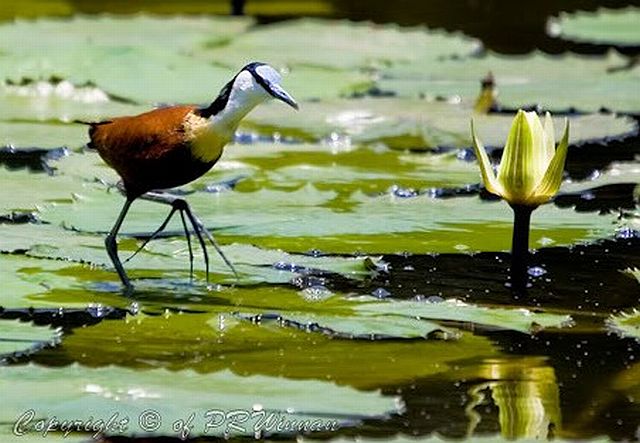
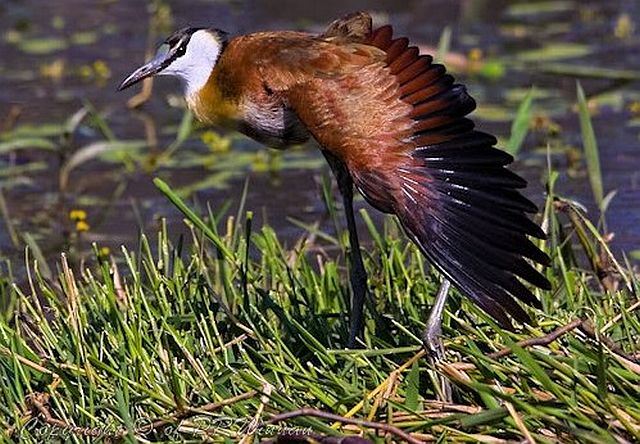
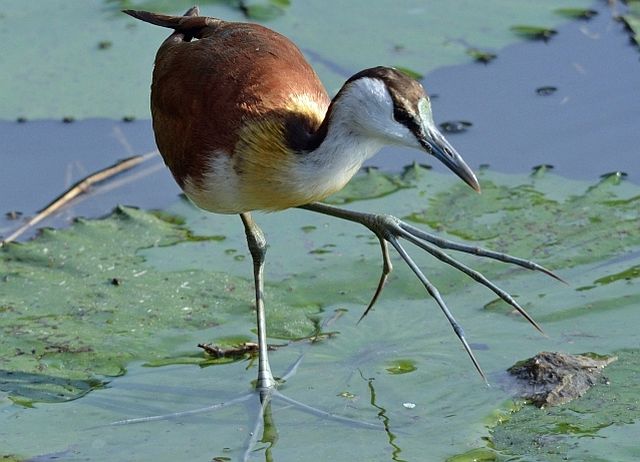 © BluTuna
© BluTuna
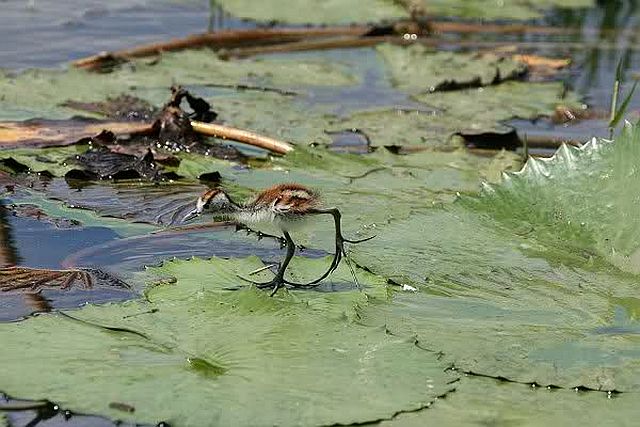 © nan
© nan
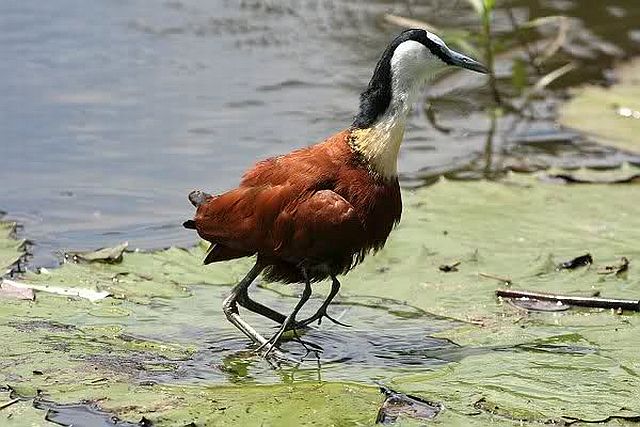 © nan
© nan
Male African Jacana carrying a chick under its wing.
Links:
Species text Sabap1
Sabap2
Roberts online


 © BluTuna
© BluTuna © nan
© nan © nan
© nan Male African Jacana carrying a chick under its wing.
Links:
Species text Sabap1
Sabap2
Roberts online
http://prwinnan.wix.com/prwinnan-photography
Family Scolopacidae (Sandpipers, Snipes)
The Scolopacidae Sandpipers are a large family of waders or shorebirds. They include many species called sandpipers, as well as those called by names such as curlew and snipe.
This large family is often further subdivided into groups of similar birds. These groups do not necessarily consist of a single genus, but as presented here they do form distinct monophyletic evolutionary lineages. The groups are:
- Curlews: Genus Numenius (8 species, of which 1–2 recently extinct)
- Upland Sandpiper: Genus Bartramia (monotypic)
- Godwits: Genus Limosa (4 species)
- Dowitchers: Genus Limnodromus (3 species)
- Snipe and woodcocks: Genera Coenocorypha, Lymnocryptes, Gallinago and Scolopax (nearly present 30 species)
- Phalaropes: Genus Phalaropus (3 species)
- Shanks and tattlers: Genera Xenus, Actitis, and Tringa which now includes Catoptrophorus and Heteroscelus (16 species)
- Polynesian sandpipers: Genus Prosobonia (1 extant species)
- Calidrids and turnstones: Roughly 25 species, mostly in Calidris which might be split up into several genera. Other genera currently accepted are Aphriza, Eurynorhynchus, Limicola, Tryngites, and Philomachus, in addition to the 2 Arenaria turnstones.
The majority of these species eat small invertebrates picked out of the mud or soil. Sandpipers are more geared towards tactile foraging methods than the plovers, which favour more visual foraging methods, and this is reflected in the high density of tactile receptors in the tips of their bills. These receptors are housed in a slight horny swelling at the tip of the bill. Bill shape is highly variable within the family. Different lengths of bills enable different species to feed in the same habitat, particularly on the coast, without direct competition for food.
Sandpipers have long bodies and legs, and narrow wings. Most species have a narrow bill, but otherwise the form and length are quite variable. They are small to medium sized birds, measuring 12–66 cm in length. The bills are sensitive, allowing the birds to feel the mud and sand as they probe for food. They generally have dull plumage, with cryptic brown, grey, or streaked patterns, although some display brighter colours during the breeding season.
Most species nest in open areas, and defend their territories with aerial displays. The nest itself is a simple scrape in the ground, in which the bird typically lays three or four eggs. The young of most species are precocial.
The sandpipers have a cosmopolitan distribution, occurring across most of the world's land surfaces except for Antarctica and the driest deserts. A majority of the family breed at moderate to high latitudes in the Northern Hemisphere, in fact accounting for the most northerly breeding birds in the world.
This large family is often further subdivided into groups of similar birds. These groups do not necessarily consist of a single genus, but as presented here they do form distinct monophyletic evolutionary lineages. The groups are:
- Curlews: Genus Numenius (8 species, of which 1–2 recently extinct)
- Upland Sandpiper: Genus Bartramia (monotypic)
- Godwits: Genus Limosa (4 species)
- Dowitchers: Genus Limnodromus (3 species)
- Snipe and woodcocks: Genera Coenocorypha, Lymnocryptes, Gallinago and Scolopax (nearly present 30 species)
- Phalaropes: Genus Phalaropus (3 species)
- Shanks and tattlers: Genera Xenus, Actitis, and Tringa which now includes Catoptrophorus and Heteroscelus (16 species)
- Polynesian sandpipers: Genus Prosobonia (1 extant species)
- Calidrids and turnstones: Roughly 25 species, mostly in Calidris which might be split up into several genera. Other genera currently accepted are Aphriza, Eurynorhynchus, Limicola, Tryngites, and Philomachus, in addition to the 2 Arenaria turnstones.
The majority of these species eat small invertebrates picked out of the mud or soil. Sandpipers are more geared towards tactile foraging methods than the plovers, which favour more visual foraging methods, and this is reflected in the high density of tactile receptors in the tips of their bills. These receptors are housed in a slight horny swelling at the tip of the bill. Bill shape is highly variable within the family. Different lengths of bills enable different species to feed in the same habitat, particularly on the coast, without direct competition for food.
Sandpipers have long bodies and legs, and narrow wings. Most species have a narrow bill, but otherwise the form and length are quite variable. They are small to medium sized birds, measuring 12–66 cm in length. The bills are sensitive, allowing the birds to feel the mud and sand as they probe for food. They generally have dull plumage, with cryptic brown, grey, or streaked patterns, although some display brighter colours during the breeding season.
Most species nest in open areas, and defend their territories with aerial displays. The nest itself is a simple scrape in the ground, in which the bird typically lays three or four eggs. The young of most species are precocial.
The sandpipers have a cosmopolitan distribution, occurring across most of the world's land surfaces except for Antarctica and the driest deserts. A majority of the family breed at moderate to high latitudes in the Northern Hemisphere, in fact accounting for the most northerly breeding birds in the world.
Family Scolopacidae (Sandpipers, Snipes) Index
Species indigenous to southern Africa:
Family Scolopacidae (Sandpipers, Snipes)
Gallinago nigripennis African Snipe 286
Gallinago media Great Snipe 285
Rostratula benghalensis Greater Painted-Snipe 242
Limosa limosa Black-tailed Godwit 287
Limosa haemastica Hudsonian Godwit 914
Limosa lapponica Bar-tailed Godwit 288
Numenius phaeopus Whimbrel 290
Numenius arquata Eurasian Curlew 289
Tringa erythropus Spotted Redshank 267
Tringa totanus Common Redshank 268
Tringa stagnatilis Marsh Sandpiper 269
Tringa nebularia Common Greenshank 270
Tringa melanoleuca Greater Yellowlegs 906
Tringa flavipes Lesser Yellowlegs 902
Tringa ochropus Green Sandpiper 265
Tringa glareola Wood Sandpiper 266
Xenus cinereus Terek Sandpiper 263
Actitis hypoleucos Common Sandpiper 264
Arenaria interpres Ruddy Turnstone 262
Calidris tenuirostris Great Knot
Calidris canutus Red Knot 271
Calidris alba Sanderling 281
Calidris ruficollis Red-necked Stint 276
Calidris minuta Little Stint 274
Calidris temminckii Temminck's Stint 280
Calidris subminuta Long-toed Stint 275
Calidris fuscicollis White-rumped Sandpiper 277
Calidris bairdii Baird's Sandpiper 278
Calidris melanotos Pectoral Sandpiper 279
Calidris ferruginea Curlew Sandpiper 272
Calidris alpina Dunlin 273
Calidris falcinellus Broad-billed Sandpiper 283
Tryngites subruficollis Buff-breasted Sandpiper 282
Calidris pugnax Ruff 284
Phalaropus tricolor Wilson's Phalarope 293
Phalaropus lobatus Red-necked Phalarope 292
Phalaropus fulicaria Red Phalarope 291
Family Scolopacidae (Sandpipers, Snipes)
Gallinago nigripennis African Snipe 286
Gallinago media Great Snipe 285
Rostratula benghalensis Greater Painted-Snipe 242
Limosa limosa Black-tailed Godwit 287
Limosa haemastica Hudsonian Godwit 914
Limosa lapponica Bar-tailed Godwit 288
Numenius phaeopus Whimbrel 290
Numenius arquata Eurasian Curlew 289
Tringa erythropus Spotted Redshank 267
Tringa totanus Common Redshank 268
Tringa stagnatilis Marsh Sandpiper 269
Tringa nebularia Common Greenshank 270
Tringa melanoleuca Greater Yellowlegs 906
Tringa flavipes Lesser Yellowlegs 902
Tringa ochropus Green Sandpiper 265
Tringa glareola Wood Sandpiper 266
Xenus cinereus Terek Sandpiper 263
Actitis hypoleucos Common Sandpiper 264
Arenaria interpres Ruddy Turnstone 262
Calidris tenuirostris Great Knot
Calidris canutus Red Knot 271
Calidris alba Sanderling 281
Calidris ruficollis Red-necked Stint 276
Calidris minuta Little Stint 274
Calidris temminckii Temminck's Stint 280
Calidris subminuta Long-toed Stint 275
Calidris fuscicollis White-rumped Sandpiper 277
Calidris bairdii Baird's Sandpiper 278
Calidris melanotos Pectoral Sandpiper 279
Calidris ferruginea Curlew Sandpiper 272
Calidris alpina Dunlin 273
Calidris falcinellus Broad-billed Sandpiper 283
Tryngites subruficollis Buff-breasted Sandpiper 282
Calidris pugnax Ruff 284
Phalaropus tricolor Wilson's Phalarope 293
Phalaropus lobatus Red-necked Phalarope 292
Phalaropus fulicaria Red Phalarope 291


